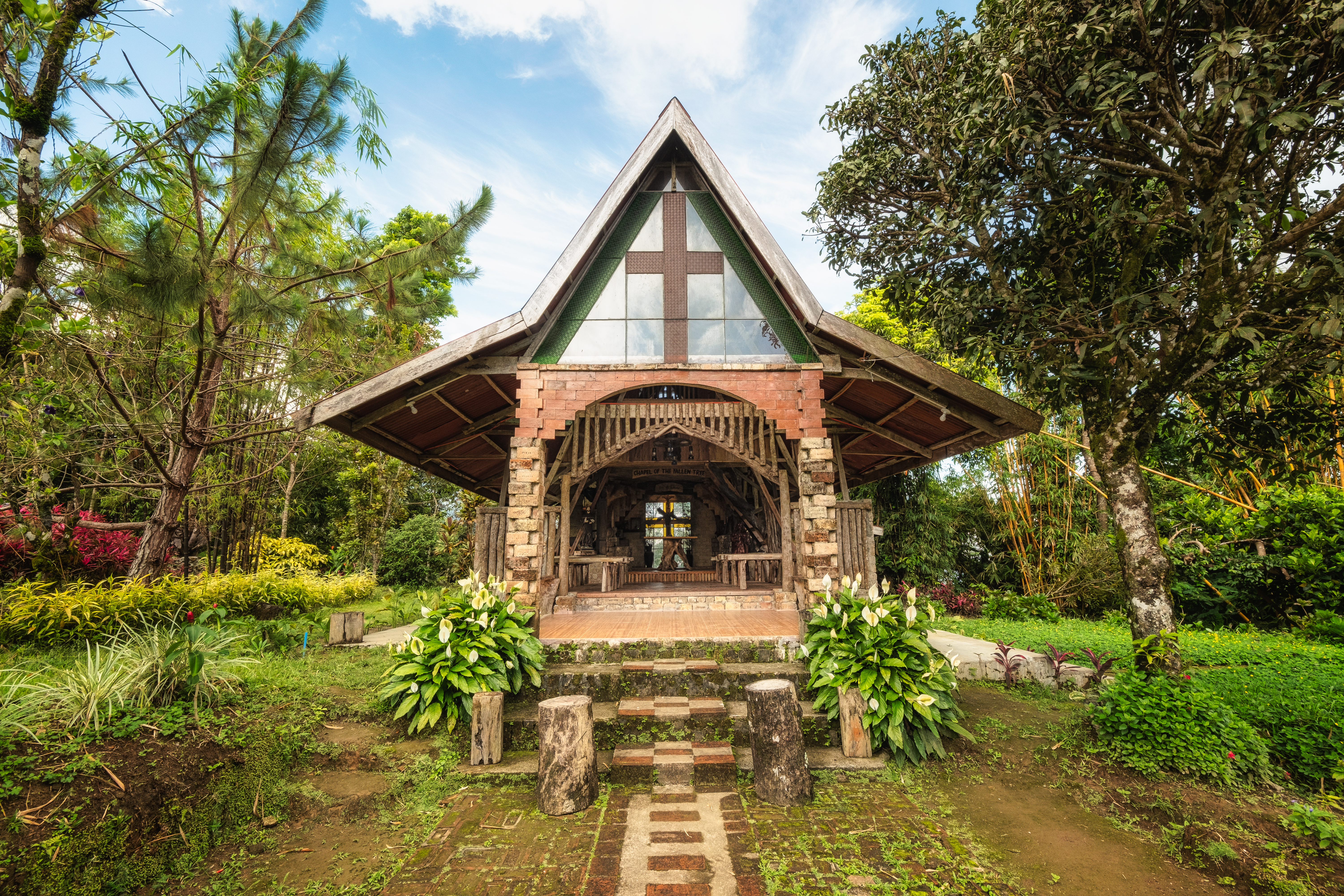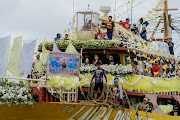Following the success of last year’s virtual visita iglesia and the positive feedback it received, Negros Season of Culture once again embarks on another pilgrimage to seven churches this Holy Week. This year, the prayers and reflections are led by Rev. Fr. Raphael Babano of the Marian Missionaries of the Holy Cross (MMHC), who guides us through seven of the most charming chapels in Negros Occidental.
These chapels are not big like cathedrals nor grand like heritage churches. Some of them lie off the beaten path, hidden away, but no less precious or significant for that. Each one was lovingly built, usually out of an intensely personal vision or necessity. They offer not only aesthetic pleasures, but also fascinating, moving stories about their construction and ministry.
Completed in 1966, the Doña Corazon Locsin Montelibano Chapel on the University of St. La Salle campus in Bacolod City was designed by National Artist for Architecture Leandro V. Locsin. It is an early example of his characteristic modernist, brutalist style, and has been designated an Important Cultural Property by the Philippine government
In Bacolod City, two chapels might be considered works of art: one for its structure, the other for its decorations. The Doña Corazon Locsin Montelibano Memorial Chapel, built in 1966 on the University of St. La Salle campus, is an early work by Negrense Leandro V. Locsin, who would go on to become a National Artist for Architecture. In the spare, modernist design of the chapel, one can see Locsin developing his signature Brutalist style and rehearsing ideas for later projects, like the Cultural Center of the Philippines. 
Within the pyramid-shaped roof of the Virgen sang Barangay Chapel in Bacolod City is an octagonal domed ceiling supported by a network of trusses. Descending from the center like manna from heaven is an eight-pointed chandelier composed of 7,000 pairs of white cup shells, or litog.
On the other hand, in a more nondescript structure, the Virgen sang Barangay Chapel in Santa Clara Subdivision houses a priceless nacreous treasure: a 9 x 21-foot mosaic mural made entirely of seashells. Created by Leticia Sia Ledesma, the shimmering mural depicts Our Lady of the Barangay and the infant Jesus attending a seaside village on the coast of Negros, with Guimaras and Panay in the distance. All other decorations in the chapel–altar, pulpit, icons–are also encrusted with seashells, each chosen for its color and cut into the required shape.
The CICM Mission Center Maryshore stands on a generous plot of land by the sea, overlooking the Guimaras Strait. Formerly a seminary of the Congregation of the Immaculate Heart of Mary from the 1960s to the 1990s, it now hosts and conducts religious activities such as retreats and recollections.
In Talisay City, the Maryshore Mission Center, operated by the Congregation of the Immaculate Heart of Mary (CICM), began offering community masses to the public during the pandemic. The center is ordinarily a private facility for religious events and activities, but its spacious gardens on the shore of Guimaras Strait proved ideal for social distancing requirements, so they opened their doors to a congregation that needed their ministry.
The Chapel of the Fallen Tree in Patag, Silay City, is made almost entirely of discarded wood and repurposed building materials. Its rustic aesthetic and quirky design result from its ongoing modification and refurbishment.
Within the forests of Patag in Silay City, the Patagoña residential compound encloses the Chapel of the Fallen Tree. Made almost entirely out of repurposed wood and upcycled building materials, the Benedictine-inspired chapel is an ongoing pet project of Patagoña owners Boy and Ching Calseña–their tribute to protected Negros forests.
The St. Joseph the Worker Chapel in Victorias City is a multi-layered artwork. The modernist architecture houses the Alfonso Ossorio mural “The Last Judgment,” as well as wooden sculptures by Benjamin Valenciano, and brasswork decoration by Arcadio Anore on the altar and pulpits.
Further north, within the Victorias Milling Company compound in Victorias City, is the world-famous St. Joseph the Worker Chapel, built in 1948, known for the astonishing mural “The Last Judgment” by Alfonso Ossorio. Often referred to as “The Angry Christ,” the mural shares the chapel (itself one of the earliest examples of modernist architecture in Asia) with other artworks, most notably the Filipinized wooden religious icons carved by Benjamin Pascual, the brasswork decorations by Arcadio Anore, and the Byzantine-style broken-glass mosaics by Adelaide de Bethune.
Discarded wooden bullcart wheels are the dominant building materials of the Chapel of the Cartwheels in Manapla. Cartwheels form the walls of the chapel as well as its rose windows, which are decorated with broken softdrink and beer bottles. The circular motif represents an eternal life through Christ, with no beginning or end.
On the Gaston family estate in neighboring Manapla, Hacienda Sta. Rosalia, stands the Chapel of the Cartwheels. Built entirely out of discarded farm implements (such as cartwheels) and building materials from the hacienda, and rocks and sand from the nearby beach, and designed by Monsignor Guillermo Gaston and his brother-in-law Jerry Ascalon, the chapel brings the Gaston family and the hacienda community together in fellowship under God.
At sunset, vermilion light cuts through the glass walls of the seven-sided Kapilya San Miguel in Don Salvador Benedicto. A heptagonal monitor roof perched above the main roof allows light and air into the chapel and evokes a salakot crowning the structure.
And finally, in Don Salvador Benedicto to the southeast is Kapilya San Miguel, which watches over the Manggapuri wellness villas. The brainchild of Manggapuri owners Chi and Raoul Flores, the chapel is an austere, breezy, Zen-infused space with locally sourced natural materials and a 360-degree view of the Canlaon mountain range.
These seven charming chapels barely scratch the surface of the spiritual experiences available in Negros Occidental. Through this virtual visita iglesia, they can be enjoyed by everyone from anywhere in the world.
Text By: Vicente Garcia Groyon
Photos By: John Kimwell Laluma
Video By: Grilled Cheese Studios
A Most Charming Visita Iglesia
by
Negros Season of Culture •
Thursday, April 14, 2022
Design and Architecture
Cultural Experience
Art and Craft
Food
People
BAO
-

Negros Season of Culture

Rooted. Taking on the World.
A global messaging system that promotes the cultural assets of Negros as shaped by its rich heritage and traditions, the unique identity of the place, and the talent of its people.
Popular Posts
Linutik
Friday, August 27, 2021

Chicken Ubad with Monggo (Chicken with Banana Pith and Mung Beans)
Thursday, July 15, 2021

Dinagsa Festival
Sunday, January 07, 2024
Rooted. Taking on the World.
Negros Season of Culture is a global messaging system that promotes the cultural assets of Negros as shaped by its rich heritage and traditions, the unique identity of the place, and the talent of its people.
Search This Site
Quick Links
People
Design and Architecture
Upcoming Events
Art and Craft
BAO
Food
Menu Footer Widget
Rooted. Taking on the World.
A global messaging system that promotes the cultural assets of Negros as shaped by its rich heritage and traditions, the unique identity of the place, and the talent of its people.
Search This Site
Upcoming Events
 Negros Season of Culture Celebrates National Heritage Month
Negros Season of Culture Celebrates National Heritage Month
The Negros Season of Culture Celebrates National Heritage Month this... Negros Season of Culture joins the National Commission on Culture and the Arts in celebrating National Heritage Month
Negros Season of Culture joins the National Commission on Culture and the Arts in celebrating National Heritage Month
Negros Season of Culture joins the National Commission on Culture...
Menu Footer Widget
• Copyright © -2021
- Negros Season of Culture



